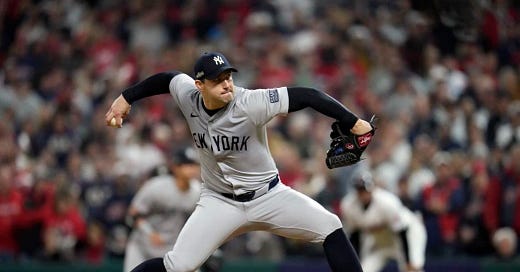Overanalytical Vogt Puts Cleveland Off Guard, Helping Yankees Prevail In Epic Game 4
Major League Baseball has become so analytically driven, it seems like managers have lost the feel for, well, managing, as if they’re supposed to function like robotic algorithm engineers compelled by some magic program for winning baseball.
A starting pitcher “going deep” into a game means getting through 7 innings, a feat that has yet to be achieved by any hurler through four games of the American League Championship Series between the Yankees and Guardians. That’s because the numbers show that pitchers on average are less effective the third and fourth times through the order.
It has turned nearly every game into a “bullpen game”, and even then the formulas rule. For the Yankees had to have been ecstatic when Cleveland manager Stephen Vogt swapped out Hunter Gaddis for Emmanuel Clase for the top of the ninth inning of Friday night’s tied Game 4, a second consecutive epic decided by bullpens playing a version of, “Can You Top This?” In this one, the Yankees squeezed out a pair of runs off Clase to hold on for an 8-6 victory and a 3-1 series lead.
Of course the program called for Clase to enter in that moment, for he had been virtually untouchable throughout the regular season. In the playoffs, however, he’s been roughed up like Mike Tyson’s first 15 boxing opponents, posting a 9.00 ERA after surrendering back-to-back home runs to Aaron Judge and Giancarlo Stanton in blowing a Game 3 save opportunity.
Gaddis, meanwhile, had the Yankees completely bamboozled in the eighth, striking out Judge, Jazz Chisholm, and Stanton with nary a menacing swing. His stuff was that electric.
I don’t care what the computer spit out, you bring Gaddis back out for the ninth of a must-win game until he showed you otherwise. It’s not like he had been stretched recently—he threw 10 pitches the previous night after a day off.
Credit the Yankees for a series of winning at bats in the ninth to reverse the Guardians’ momentum from overcoming a 6-2 deficit, with Anthony Rizzo, Anthony Volpe, and Gleyber Torres sandwiching base hits around a squib by Alex Verdugo that Cleveland shortstop Brayan Rocchio booted. Unlike their offense from much of the series that was driven by the long ball, New York was able to put up a crooked number in the most clutch of spots through old school hitting and speed on the basepaths (Jon Berti pinch ran for the plodding Rizzo).
It had to take Yankees manager Aaron Boone great restraint to give his closer Luke Weaver the night off after he gagged away Game 3 with one strike to go. Unlike Vogt, Boone has few viable options in his bullpen. Tommy Kahnle, with his array of changeups, is not what is typically called for in these situations of the highest leverage. But Kahnle got through it, despite putting the tying runs on base.
I wasn’t a fan of Boone using Weaver in Game 2 with the Yankees up, 6-2, heading into the ninth. Yes, Cleveland had the heart of its order due up and Boone may have been skittish by stats that showed the possibility of helping the opponent set up a big inning, but four runs up with three outs to go? The odds had to be heavily in New York’s favor no matter who they pitched. Who knows, maybe the otherwise meaningless dinger hit by Cleveland third baseman Jose Ramirez took the bloom off Weaver’s pristine (no runs allowed in 6 prior postseason innings) rose and teed up the next game’s meltdown.
Confidence is a tricky thing to measure, no matter how hard the analytics try.



